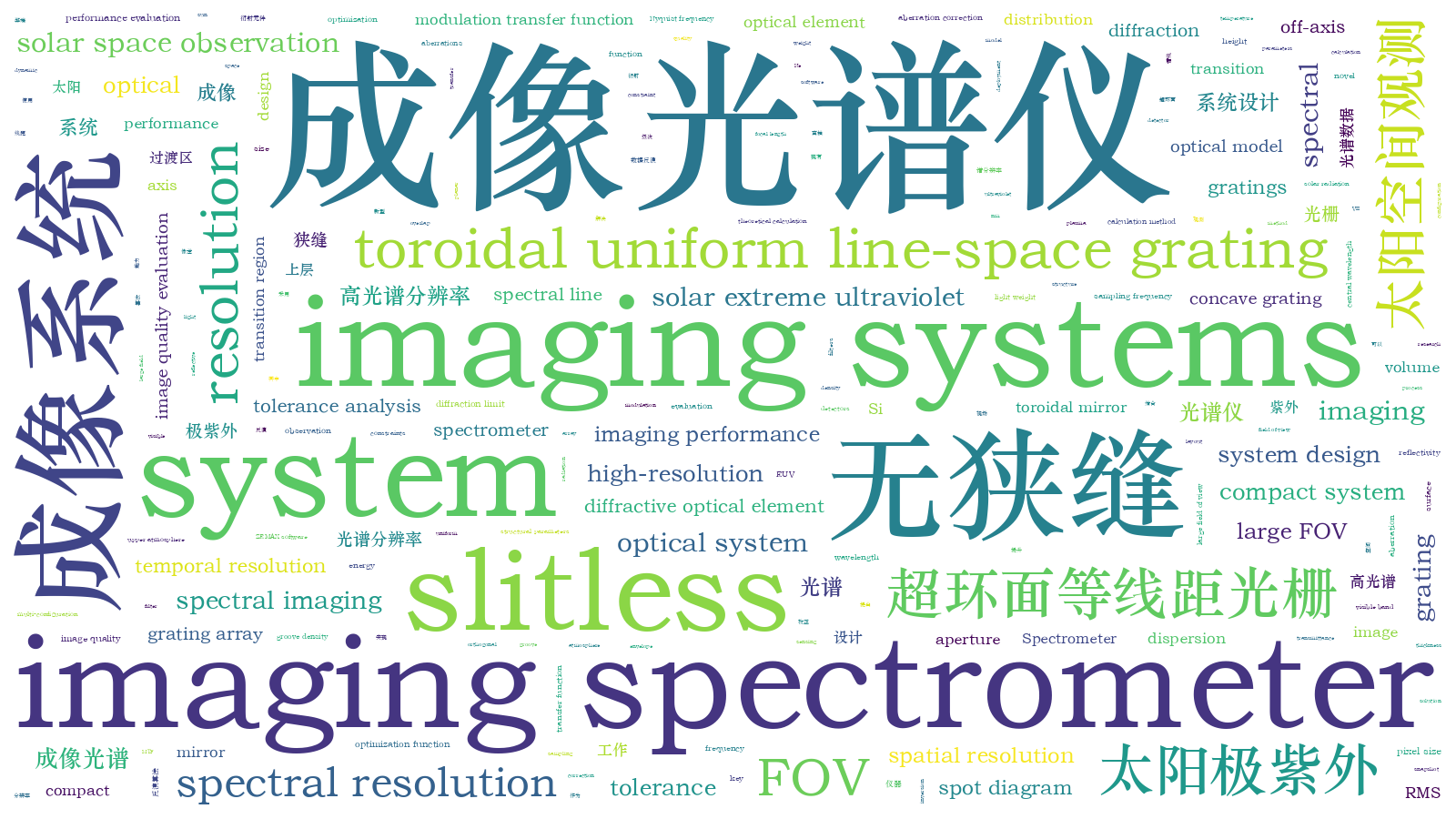太阳上层过渡区极紫外三级次无狭缝成像光谱仪系统设计
Solar transition region is a highly dynamic plasma region with a temperature of 0.02-1 MK in the solar upper atmosphere, which is the key field of solar physics research. Extreme ultraviolet (EUV) multi-order slitless imaging spectrometer can observe the sun in a large field of view (FOV) simultaneously with high spectral, spatial, and temporal resolution. We propose and design a novel solar EUV slitless imaging spectrometer operating at Ne VII 46.52 nm. This instrument can simultaneously correct the off-axis grating aberrations of three diffraction orders in a large FOV (24′×24′) while meeting the requirements of light weight, compact volume, and large aperture. We hope that our three-order slitless spectral imaging strategy and system design can provide a technical scheme that can achieve continuous snapshot high-resolution spectral imaging observations of the upper transition region.
This instrument utilizes two toroidal uniform line-space (TULS) gratings and a toroidal mirror as the diffraction element and the reflective element respectively to realize a new three-order spectral dispersion structure. The ±1 order dispersion planes overlap with each other and are orthogonal to the 0-order imaging plane without dispersion. We build the paraxial optical model and calculate the initial solution of the optical system. By adopting the multi-configuration of ZEMAX software and the self-defined optimization function, the initial structural parameters of the three-order subsystems are globally optimized by considering the aberration correction conditions of the TULS grating, system resolution requirements, and geometric constraints. Finally, the tolerance analysis is carried out to obtain an optical system with reasonable tolerance allocation.
Figs. 6 (a)-(c) show the optical layout of the entire instrument, ±1 order subsystems, and 0-order subsystems respectively. This instrument consists of three hyperboloidal mirrors with off-axis aperture, three Si filters, two TULS gratings, a toroidal mirror, a field aperture, and three independent planar detectors. This entire instrument has a compact optical envelope volume of 950 mm×280 mm×240 mm, the focal length is 3200 mm, and the FOV is 24′×24′. Meanwhile, we employ a Si filter with a thickness of 0.1 μm to suppress the strong solar radiation in the visible band. The transmittance curve is shown in Fig. 7. The same periodic Sc/Si multilayers are coated at all optical surfaces to provide the reflectivity at 46.52 nm. The reflectivity curve is shown in Fig. 8. To reduce the conversion costs of the system, we add constraint conditions in the optimization process to make the final optimized TULS grating and mirror have identical surface height distribution and grating groove density. The surface height distribution is shown in Fig. 9.
Figs. 10 (a)-(c) are the RMS radius field map of the spot diagram of the three-order subsystems. Except for the marginal FOV of +1 order, the RMS radius of the spot diagram in the full FOV of each order is less than half of the pixel size. Figs. 11 (a)-(c) are the three-order modulation transfer function (MTF) curves respectively. Except for a few marginal FOV, all orders are greater than 0.6 at the Nyquist frequency (41.67 lp/mm), which is close to the diffraction limit. The image quality evaluation shows that the system has excellent imaging performance.
Figs. 12 (a)-(c) are the geometric ensquared energy curves of the instrument. Except for a few marginal FOV, the square full width with 80% ensquared energy at all orders is less than the pixel size. Considering the sampling frequency of the detector, the spatial resolution of the system is 1.547″. By adopting the theoretical calculation method, we obtain the pixel spectral resolution (Δλ) at -1 order and +1 order is 0.00622 nm and 0.00509 nm,respectively. The spot diagram distribution in the full FOV at ±1 order is shown in Figs. 13 (a)-(b). The spot diagram of three wavelengths with a wavelength difference Δλ is obviously separated on the image plane, which indicates that the spectral resolution of the system is 0.0078 nm.
Table 5 shows the tolerance limits of key components of the system. Under this tolerance, the RMS radius of the spot diagram on the image plane has a 90% probability of changing within 7.44 μm, and an 80% probability of changing within 6.4 μm. Tolerance analysis is carried out for the system with single grating working simultaneously at three orders. The results are shown in Table 5. The comparison shows that the designed instrument has a looser tolerance.
We propose and design a novel three-order slitless imaging spectrometer. A concave grating array is adopted as the diffractive optical element, and a single grating only works at a single diffraction order to correct the off-axis grating aberration in a large FOV. This system selects Ne VII 46.52 nm spectral line as the central wavelength, and it can realize high-resolution observation under a large FOV (24′×24′). The spatial resolution of the system is 1.547″, and the spectral resolution obtained by spectral data inversion is 0.0078 nm. The performance evaluation and tolerance analysis of the system show that the new imaging spectrometer has excellent imaging performance, compact system volume, and loose tolerance. Thus, it is suitable for deployment on remote-sensing satellite platforms to achieve high-resolution observation of solar upper-layer transition regions.
沈文杰, 邢阳光, 黄一帆, 彭吉龙, 代树武, 王颖, 朱成林, 闫雷, 刘越, 李林. 太阳上层过渡区极紫外三级次无狭缝成像光谱仪系统设计[J]. 光学学报, 2024, 44(6): 0611001. Wenjie Shen, Yangguang Xing, Yifan Huang, Jilong Peng, Shuwu Dai, Ying Wang, Chenglin Zhu, Lei Yan, Yue Liu, Lin Li. System Design of Extreme Ultraviolet Three-Order Slitless Imaging Spectrometer for Solar Upper Transition Region[J]. Acta Optica Sinica, 2024, 44(6): 0611001.







